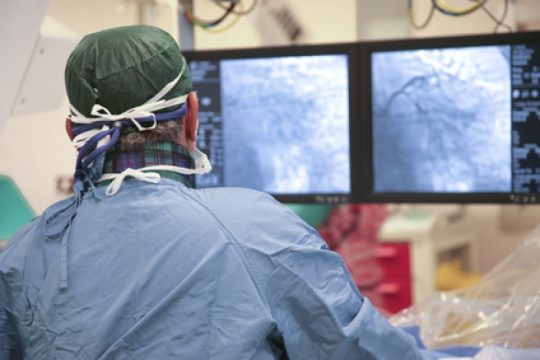Mitral regurgitation is the most common valvular heart disease. Its cause is most frequently functional or secondary dysfunction (functional mitral regurgitation, FMR) compared with degenerative mitral regurgitation (DMR), which is associated with decreased ventricular function, hospitalization for heart failure, and mortality.

While medical treatment is effective over extended periods, a significant number of patients cannot undergo surgery due to high or extreme surgical risk.
Edge-to-edge treatment has emerged as a valid alternative with promising results compared to comprehensive medical treatment, as shown in the COAPT Study. However, until now, only this analysis and other smaller studies are available, especially regarding long-term outcomes.
The CLASP Study included 124 patients with symptomatic severe mitral regurgitation, of whom 85 had FMR and 39 had DMR.
Major adverse events (MAEs) were assessed at 3 years. MAEs were defined as the presence of cardiovascular mortality, stroke, acute myocardial infarction, need for dialysis, severe bleeding, and device-related reintervention.
Mean age was 75 years, and 55% of subjects were male. About 83% of patients had hypertension, 36% had diabetes, 12% had suffered a prior stroke, 63% had atrial fibrillation, 30% had impaired renal function, 24% had pulmonary hypertension, 35% had moderate to severe tricuspid insufficiency, and NT BNP levels were 4,148 pg/mL.
At 3 years, the MAEs rate was 26.6% (30.6% for FMR and 17.9% for DMR); for cardiovascular mortality, it was 14.5% (18.8% for FMR and 5.1% for DMR). About 4.0% of patients had experienced a stroke (4.7% for FMR and 2.6% for DMR), 3.2% had experienced an acute myocardial infarction (2.4% for FMR and 5.1% for DMR), and 2 patients had required reintervention.
The 3-year survival rate was 74.6% (66.0% for FMR and 91.7% for DMR), and the rate for freedom from rehospitalization for heart failure was 73.1% (63.9% for FMR and 91.1% for DMR).
Read also: Cerebrovascular Events in the COAPT Study.
The annualized hospitalization rate at 3 years decreased by 85%, from 1.17 before the procedure to 0.18 (81% for FMR and 96% for DMR; in both types of mitral regurgitation, p <0.001), and there was a significant improvement in functional class. Additionally, there was a significant reduction in ventricular volume and mitral regurgitation at 30 days, which was maintained at 3 years for both DMR and FMR.
Conclusion
The 3-year results of the CLASP Study demonstrate the durability and favorable evolution of the PASCAL System in symptomatic patients with severe mitral regurgitation. These results further support the use of the PASCAL System as a valuable therapy for patients with symptomatic mitral regurgitation.

Dr. Carlos Fava.
Member of the Editorial Board of SOLACI.org.
Original Title: Three‐year outcomes for transcatheter repair in patients with mitral regurgitation from the CLASP study.
Reference: Konstantinos Spargias, et al. Catheter Cardiovasc Interv. 2023;102:145–154.
Subscribe to our weekly newsletter
Get the latest scientific articles on interventional cardiology





